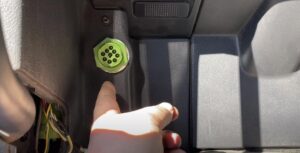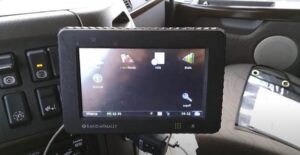
The world of heavy-duty trucks can be complex, especially when it comes to diagnostics and troubleshooting. At the heart of this is the Peterbilt diagnostic port, a critical component in modern truck maintenance. This article delves into the ins and outs of the Peterbilt diagnostic port, akin to the Kenworth diagnostic port, offering valuable insights for professionals and enthusiasts alike.
Understanding the Peterbilt Diagnostic Port
The diagnostic port in a Peterbilt truck, similar to the Kenworth diagnostic port, is essentially the communication gateway for diagnostic tools and the truck’s electronic control modules (ECMs).
Key Features
- Accessibility: Located typically below the dashboard;
- Compatibility: Works with standard diagnostic tools, much like the Kenworth diagnostic port;
- Functionality: Enables reading and clearing of diagnostic trouble codes (DTCs).
Technical Specifications
- Port Type: J1939 9-pin connector, resembling the Kenworth diagnostic port;
- Data Protocol: Supports various protocols including CAN, J1587/J1708.
Diagnostic Tools Compatible with Peterbilt Diagnostic Ports
For Peterbilt trucks, there are several diagnostic tools available that are compatible with their diagnostic ports. These tools are not only suitable for Peterbilt trucks but also for other heavy-duty vehicles, offering a range of features that cater to different needs and preferences.
| Diagnostic Scanner | Features | Compatibility | Price | Pros | Cons |
| Peterbilt Diagnostic Scanner | Forced DPF regeneration, diagnostics, reading/erasing fault codes, live data graphing, EVAP and O2 sensor tests, oil light reset, ABS testing. Covers a range of ECU systems. | Engine, transmission, instrument panel, drivetrain, braking system, EPS, ESP, fuel system, among others. | Not specified | Saves money and time by avoiding mechanic visits for certain issues. | Not specified |
| Cando HD Code II | DPF regeneration capabilities, user-friendly with a large screen, supports OBD II protocol. | Suited for commercial trucks (classes 4-8) and industrial engines. | $277 | Extends engine life by accurately defining error codes. | Limited to regenerations on specific engine models. |
| Universal Diesel Truck Diagnostic Tool Scanner | Laptop and scanner for diagnostics, Pocketfleet Diagnostics, Automatic VIN Decoder, KnowledgeBase. | Wide range of vehicle types, including Peterbilt. | $2,695 | Thorough diagnostics, access to extensive resources. | Relatively expensive and bulky. |
| Diesel Handheld Scanner | Portable, reads and clears diagnostic trouble codes, supports multiple protocols. | Various vehicles including Cummins, Detroit Diesel, Peterbilt. | $449.95 | Lifetime updates, easy to use for owner-operators. | Not specified |
| Diesel Tablet Commercial Truck Diagnostic System | Advanced features in tablet form, perpetual license software, stores history for multiple vehicles, easy navigation to repair information. | Range of vehicle types including Peterbilt. | $3,499 | Sleek design, suitable for Android users. | Not specified |
| FCAR F3-N Commercial Truck and Off-Highway Diagnostic Tool | User-friendly, straightforward interface, free unlimited software updates and support for two years. | Wide range of vehicles, including Peterbilt. | $2,995 | Fast diagnostic reads, effective for generating reports and viewing trip data. | Not specified |
Common Diagnostic Procedures

Understanding how to use the Peterbilt diagnostic port, just as one would with a Kenworth diagnostic port, is crucial for effective truck maintenance.
Steps for Diagnostic Testing
- Connect the Tool: The first step in conducting diagnostic testing on your Peterbilt or Kenworth truck is to plug your diagnostic tool into the diagnostic port. This port is typically located in the cab, accessible from the driver’s seat. Ensure that the tool is securely connected to establish a stable data link between the tool and the truck’s computer;
- Run Diagnostics: Once the diagnostic tool is connected, follow the tool’s instructions to initiate the diagnostic tests. Modern diagnostic tools are user-friendly and provide step-by-step guidance. Allow the tool to communicate with the truck’s systems and gather the necessary data;
- Interpret Results: After the diagnostic tests are complete, the tool will generate a list of diagnostic codes and data. Take the time to analyze these results carefully. Diagnostic codes are alphanumeric combinations that correspond to specific issues within the vehicle’s systems. Understanding these codes is crucial for identifying the source of the problem.
Troubleshooting Tips
While conducting diagnostic testing on your Peterbilt or Kenworth truck, you may encounter challenges or issues. Here are some troubleshooting tips to ensure a smooth diagnostic process:
- Ensure Proper Connection: Just like with the Kenworth diagnostic port, a proper connection to the Peterbilt diagnostic port is essential. If the tool is not securely connected, it may lead to communication errors or incomplete diagnostic tests. Double-check the connection to guarantee a stable link between the tool and the truck’s computer;
- Update Your Diagnostic Tool Software Regularly: Diagnostic tools often receive software updates to enhance their capabilities and compatibility with various truck models. Regularly updating your diagnostic tool’s software ensures that it can effectively communicate with the truck’s systems and interpret the latest diagnostic codes accurately;
- Consult the Truck’s Manual for Specific Diagnostic Procedures: Every Peterbilt and Kenworth truck model may have specific diagnostic procedures and nuances. To gain a deeper understanding of the diagnostic process for your particular truck, refer to the truck’s manual or documentation provided by the manufacturer. These resources can offer valuable insights into the diagnostic testing tailored to your vehicle.
The Role of the Peterbilt Diagnostic Port in Preventive Maintenance
Like the Kenworth diagnostic port, the Peterbilt port plays a pivotal role in preventive maintenance.
Preventive Maintenance Benefits:
- Early Problem Detection: Identifies potential issues before they escalate;
- Maintenance Scheduling: Helps plan routine maintenance effectively;
- Cost Savings: Reduces the likelihood of costly repairs.
Advanced Features of the Peterbilt Diagnostic Port
The Peterbilt diagnostic port, mirroring the capabilities of the Kenworth diagnostic port, offers several advanced features.
Noteworthy Features:
- Live Data Streaming: Real-time monitoring of truck’s performance;
- Historical Data Analysis: Access to past diagnostic data for trend analysis;
- ECM Programming: Ability to update or modify ECM settings.
Conclusion
The Peterbilt diagnostic port, akin to the Kenworth diagnostic port, is a vital component in modern truck maintenance. Understanding its functionality and proper use is key to ensuring the longevity and optimal performance of your Peterbilt truck. Regular use of the diagnostic port for preventive maintenance can save time, money, and ensure road safety.
FAQ
Q1: How is the Peterbilt diagnostic port different from the Kenworth diagnostic port?
A: While they share many similarities, there may be slight differences in software compatibility and location in the truck.
Q2: Can I use any diagnostic tool with the Peterbilt diagnostic port?
A: Most tools designed for heavy-duty trucks should work, but it’s best to check compatibility.
Q3: How often should I use the diagnostic port for maintenance?
A: Regular use, such as during routine maintenance checks, is recommended.
Q4: Can I perform ECM updates through the diagnostic port?
A: Yes, provided you have the appropriate tools and software.





